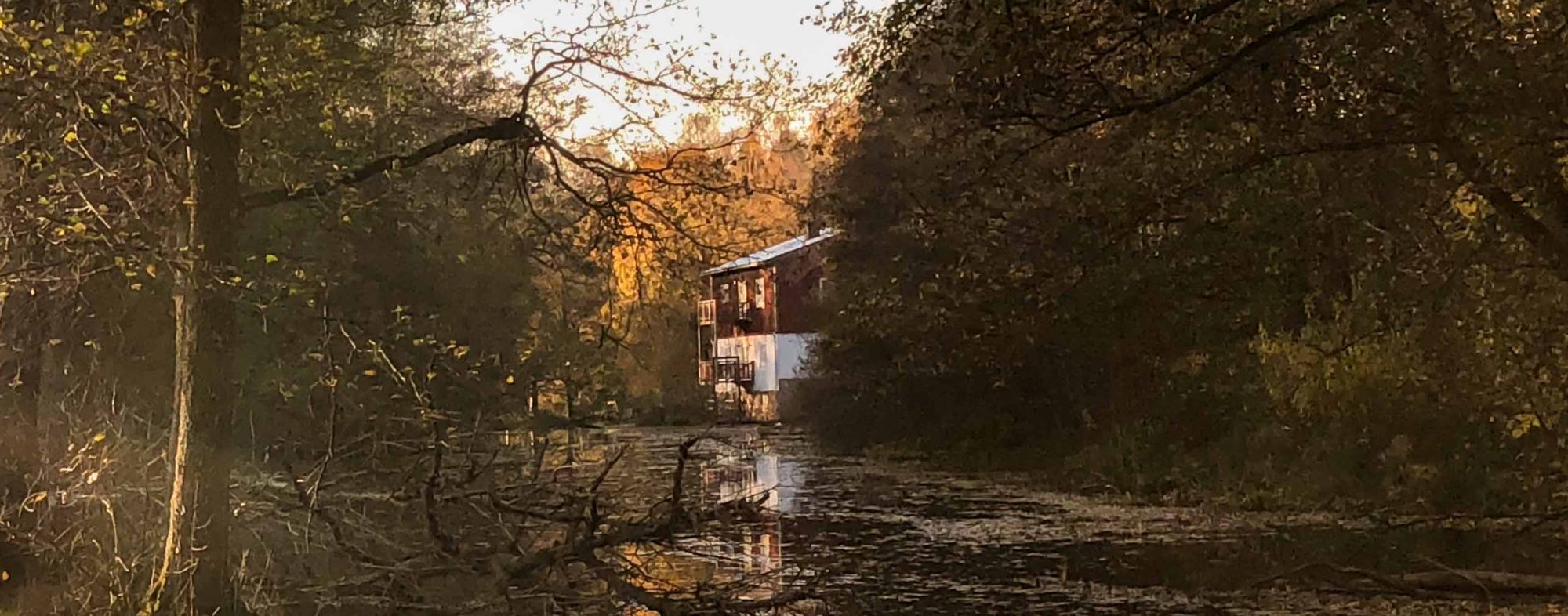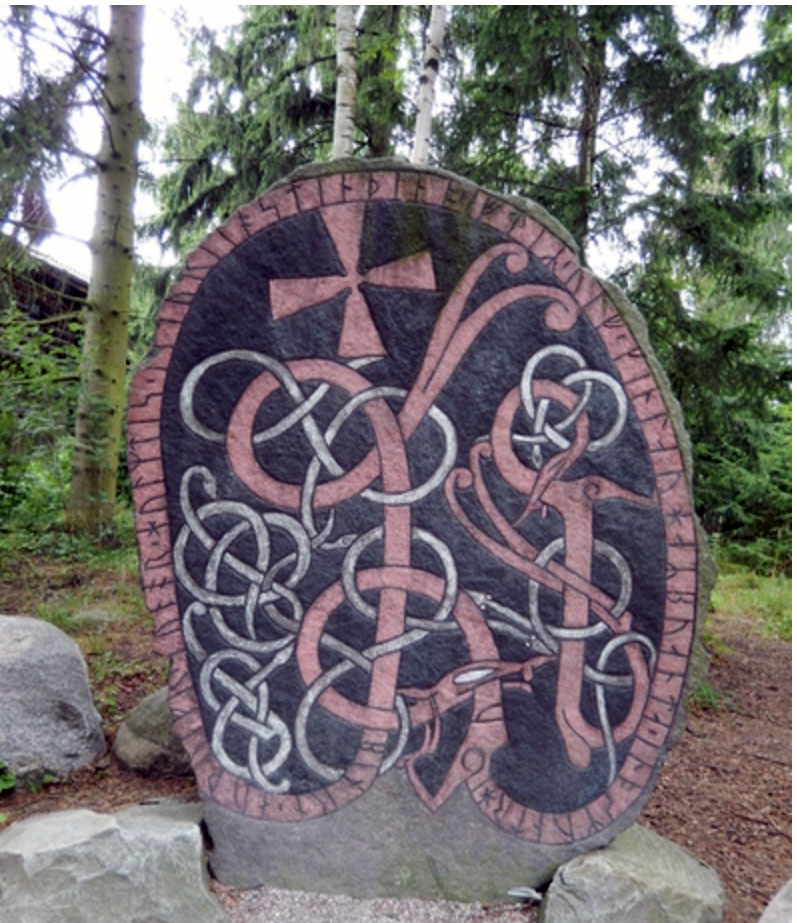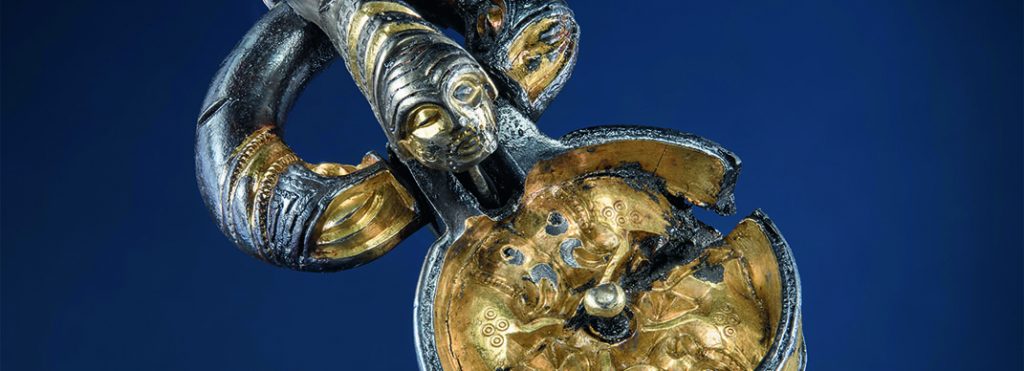
Ancient times
The legends talk about a time that may be difficult to imagine; about power, heroism, breathtakingly beautiful gold jewellery, and swords with names. But these are all just fairy tales… or are they?
In Västergötland, monuments and archaeological finds bring the fairy tales to life, not least in the area around Lake Hornborga where several of Sweden’s earliest kings and queens were buried in the soil of their forefathers. The riches and power generated by the land around the table mountains, manifested themselves as early as 5,500 years ago when humans began erecting megaliths here, and lasted until late medieval times. When monasteries were first built around the lake, powerful people donated several country estates and farms to them; one of these was Herrtorp, which ended up belonging to the nunnery at Gudhem. More about the interesting history of this area is available below – welcome to a region of fairy-tales.
Herrtorps Qvarn 1287

In a letter written in Latin by King Magnus III on the 19th of March 1287, he settles a dispute relating to the Herrtorp Mills between the nuns at Gudhem and the person operating the farm. Until the Lake Hornborga was lowered for the third time in the 1870s there were two waterfalls at Herrtorp, the upper and the lower. A number of small businesses have been run here over the centuries, and a village developed around the waterfalls and these activities. The letter has been preserved by the Swedish National Archives, SDHK 1369. At easy walking distance, southwest of Herrtorp are the ruins of Härlunda Church, beautifully located next to wetlands.
According to folklore, there used to be a sacrificial site and a rune stone here. (Perhaps the 4- metre long rock currently bricked into the church foundation?) The walk takes you past a lovely copse with remarkable stone formations, just before you reach the church ruins if you are heading away from Herrtorp, could this be the ancient sacrificial site? There is no way of knowing how old Herrtorp is, however we do know that this was already a nobleman’s house in medieval times, when it was donated to the nunnery in Gudhem. Based on this and its location by an important waterway, this site was probably already inhabited during the Viking Era, and perhaps even before the Vikings converted to Christianity.
600 years later

The mill late 1800
In 1881, a new mill was built by the lower waterfall at Herrtorps Qvarn, as part of the efforts to lower Lake Hornborga. This mill, which is the current one, was named Kristinefors Qvarn, however this name was later forgotten and replaced with the ancient name of Herrtorps Qvarn, by which the mill was known locally. By this time, the nuns at Gudhem had been out of the picture for over 350 years. During the reformation in the 1520s, Herrtorp was placed under the ownership of the state, which meant that it was under the control of the county of Visingsborg and Per Brahe. At this time, Herrtorp was home to the governor of the Hundred of Skånings, but the estate later became the residence of an army captain, under the allotment system used in the 18th and 19th century. The upper waterfall at Herrtorp was bought out by the Lake Lowering Company for Lake Hornborga (Hornborgasjöns sjösänkningsföretag), which lowered the lake five times between 1802 and 1930, to create more arable land. The present-day mill by the lower waterfall was built by the owners of the four large estates around the lake, who were also responsible for the lake lowering operation. Mr Ekberg of Dagsnäs Estate later bought out the rest of the partners, and Herrtorps Qvarn remained under the ownership of his family until the mid-1980s, when the abandoned and derelict mill was given a new lease of life, and started to be turned into what it is today, an inn for people with an interest in nature and culture.
Thingstead of all Geats and Skara

Translated from google translate, apologize for misspellings and possible errors.
In the Icelandic saga of Gunnlaug Ormstunga, Skara is stated to be a Viking-age town and in the 11th century, Adam of Bremen calls Skara "magna vicitas" - a significant place.
Incidentally, Skara's earliest history is shrouded in obscurity, but can be directly linked to the ancient town square Götala, which is now located on the outskirts of the city. Götala, or all of Götar's things as it is also called, is centrally located in the hub of the pre-Christian Uppsala desert estates. (See above) That Skara became Sweden's first religious and political center is of course no coincidence. The Gothic Svea king of Svia kind (Kinnekulle), Olof Skötkonung, chose to move the episcopate from Husaby on Kinnekulle to Skara as he "could not stand the idolatry in Uppsala and also did not want to make a change". It sounds as if Olof is talking about a nearby Uppsala where a few miles move made a difference. With Olof's story, you can also see Skara's story. To return to the Icelandic fairy tale tradition, it is told of a Västgötland stormman and Viking in the 10th century named Skoglar Toste. This stormman owned lots of farms and land in several provinces in Svitjod. On a runestone in Uppland, one can read that Toste undertook military raids to England as Ragnar Lodbrok did before him and the Danish king Knut the Great did after him, which explains his wealth.
Toste had a daughter and a son, Sigrid and Ulf. The daughter "Sigrid Storråda" married the King of Sweden Erik Segersäll and had a son Olof Skötkonung. Sigrid's brother, Ulf Tostesson became Earl of Skara and his son Ragnvald Ulfsson (Olof Skötkonung's cousin) continued to hold the office of earl. (The king's closest man) On the outskirts of Skara up on Skarabergsåsen next to Brunnsbo bishop's farm is today the name Järnsyssla, formerly Jarlsyssla, which testifies to the place's function.
Ragnvald had a son who ascended the throne in 1060, King Stenkil from Levene. Levene is about 30 km from Skara. Later, Sigrid Storråda remarried to the Danish king Sven Tveskägg and had two sons and two daughters. She was probably the mother of Knut the Great, who later became not only king over Denmark, Norway and parts of Sweden, but also England.
In other words, it could be that Olof and Knut were half-brothers.
One thing that speaks for itself is that in the Danish king Valdemar's Sejr's land register from 1231, some of Toste's farms are mentioned as Sigridslevet, ie the inheritance Sigrid Storråda's Danish descendants were entitled to. It is also mentioned that an Olof sailed his fleet with Knut to England, which in itself does not prove family ties, but rather that they were relatives.
An interesting connection is that another wife Sigrid donates Varnhem to the monks 150 years later, making it a gentleman's creature at the Swedish royal house or rather King Erik the Holy, Stockholm's patron saint and buried in G: a Uppsala. Is this wife Sigrid possibly a descendant of Sigrid Storråda? The same name was often used within a family. It may seem strange that the king in G: a Uppsala was so upset about the donation, but it would turn out that he had a very special connection to Varnhem. Isotope tests on Erik the Saint's skeleton showed that he had grown up and lived most of his life in Varnhem. In Varnhem, a large silver treasure has been found with English silver coins from Knut and Olof's army train in England, but also luxury goods from the first century AD. like for example. a Roman wine jar and skeleton of greyhound. The power elite with close ties to the king sat in Varnhem. The excavations in Varnhem have revealed the names of some of those who resided there in the early 1000s, "Kettil and Kata, Torgil's sister". The names were written in runes on Kata's tombstone, which her husband Kettil had carved.
To tie the knot, Knut's sister Estrid had a son, Svend Estridsen, who ruled as king in Denmark 1047-1074. Svend married Knut's daughter Gunhild, but the church dissolved their marriage because they were cousins. Gunhild then moved to her ancestral estate Gudhem by Hornborgasjön (the inheritance from her grandmother Sigrid Storråda) and started a monastery in 1052. (Which was mentioned under "De förkristna Uppsala ödgodsen"). The two ruling families who fought for power during the beginning of the 13th century, both have their roots in Sigrid Storråda's two marriages with a King of Sweden and a King of Denmark during the Viking Age. When Erikar and Folkungar with the help of Uppsvear and Norwegians finally win over Sverkrar and Danes, in the battle of Gestilren (about 40 km from Skara) the power struggle is over and the state of Sweden begins to be born. The crowd really carries an exciting story!
The pre-Christian Uppsala öd estates

Translated from google translate, apologize for misspellings and possible errors.
Gudhem slumbers his Sleeping Beauty sleep while waiting for an excavation. An old royal estate as it belongs to "the eight nests" of Uppsala öd (öd = wealth), as Ökull at Varnhem is also. "Uppsala" was under paganism primarily a functional name, just as we say "The Church" today, although the church must of course be located in a geographical location. Previous national romantic history writing has claimed that it is a geographical place in Uppland when in fact there were many Uppsala places in Sweden. The place names that today still bear the name Uppsala are usually old sacrificial sites whose names have survived as a geographical place despite Christianity's taboo. In Sweden today there are about 70 places that bear the name Uppsala, one of the most famous is G: a Uppsala in Uppland. The concentration of Uppsala names, on the other hand, is densest in Västergötland and then thinned out in different directions in Sweden and Norway. The city of Uppsala in Uppland (Not to be confused with G: a Uppsala) got its name in the 17th century and was formerly called Östra Aros, i.e. Västerås' equivalent of Österås. The eight Uppsala deserts are located in Skaraborg, centrally located in Västergötland, each with its own administrative area that stretched towards the outer edges of Västergötland. In the hub is Götala, all of Göta's things that were later the city of Skara built around the year 1000.
Icelandic fairy tales tell that Uppsala öd was founded by Yngve Frej, tribal hero of our oldest known royal family, the Ynglinga family. The tales also tell that Oden died in his royal palace Gudhem. In the Jomsvikingasagan it is said that Gudhem was the largest temple in Götaland, that there were hundreds of images of gods and that it was dedicated to Thor. The eight nests were also called "ancient Sigtunir", which means "the ancient Odensgårdarna". In Uppsala öds Skalunda is one of Sweden's largest royal mounds from the break between the migration period - Vendel period and not far from another Uppsala öd, Vads village by Tidan, is Sweden's second largest shipwreck - Askeberga stones. Is this the landscape of the fairy tale? In any case, it can be stated that the "eight royal estates" during the early Middle Ages still belonged to the Gothic families (Göt or Gaut is another name for Oden) who traced their lineage back to Oden and Yngve Frej.
Gudhem's royal estate was probably donated by King Karl Sverkersson sometime in the 1160s. In a papal bull from 1168, the monastery is mentioned for the first time as a Benedictine monastery. But there is information that is considered doubtful, that a monastery was founded as early as 1052. But in a new light from the excavations in Varnhem, which has preceded the entrance of Christianity by 150 years, it is no longer an "impossibility". Later during Knut Eriksson's reign, the monastery was reformed into a Cistercian monastery, where it is stated that Knut Eriksson was a donor. In any case, Gudhem's monastery is considered one of Sweden's earliest.
The founder of the state of Sweden and Stockholm, Birger Jarl, died in 1266 on the royal estate Jälbolung in Västergötland, one of the eight Uppsala deserts and is buried in Varnhem.
War booty site Finnestorp and Beowulf

Odin sacrifisies an eye in Mimer´s well to get wisdom
Information availible in short.